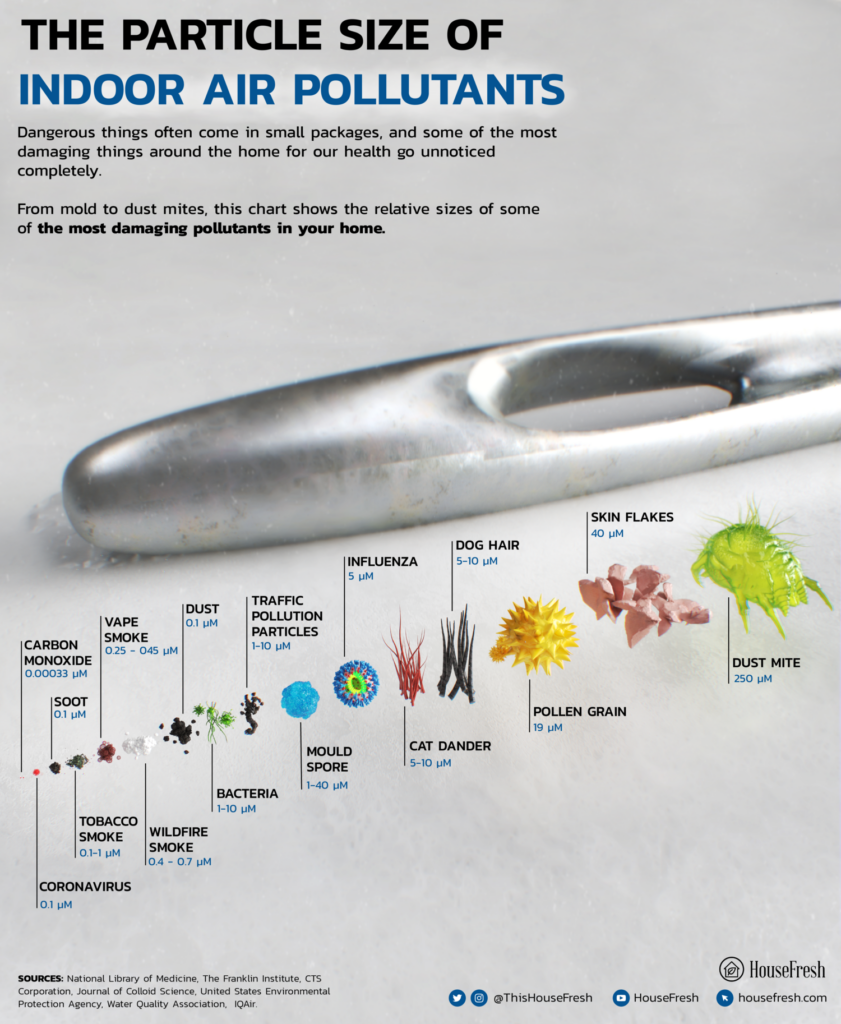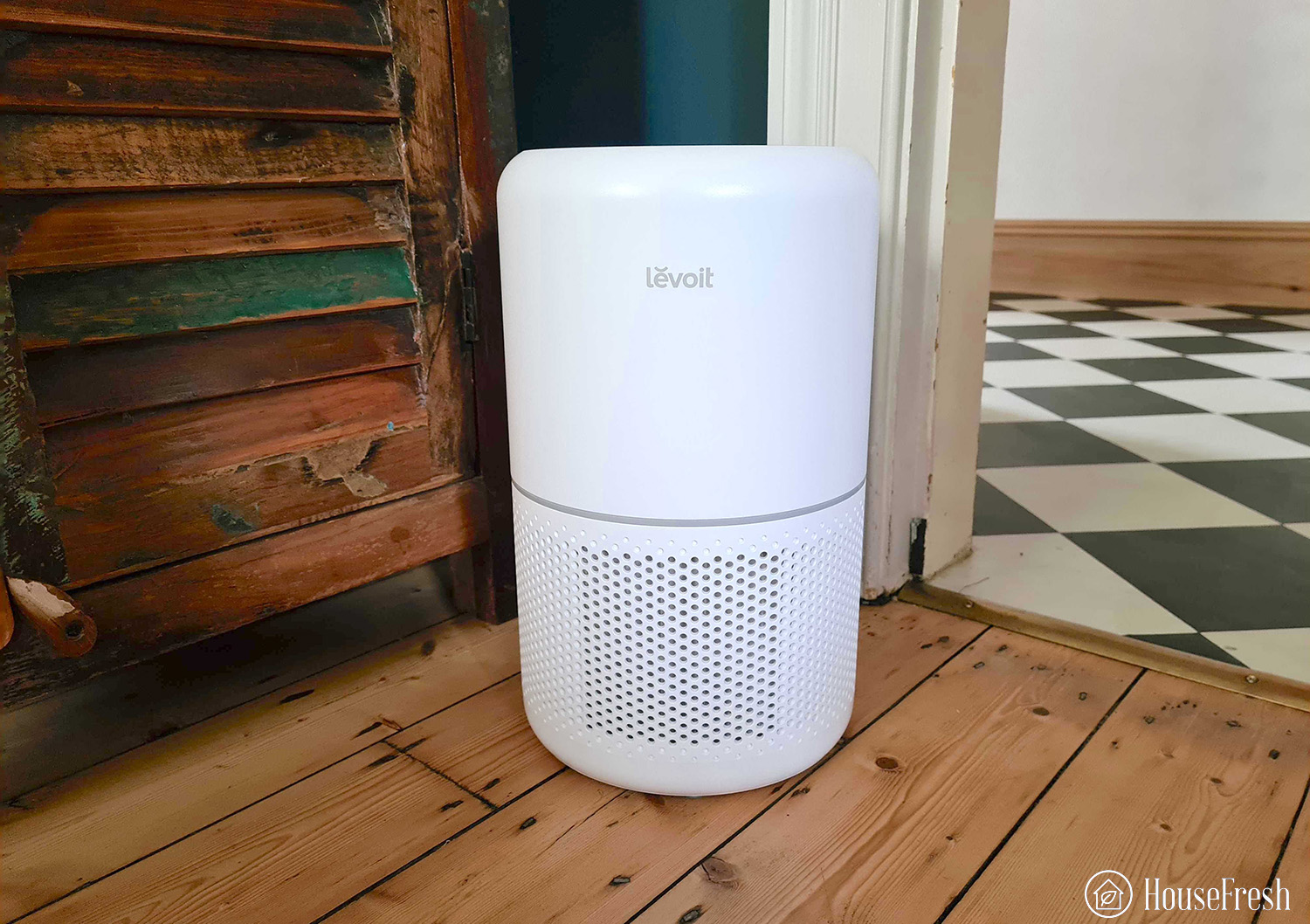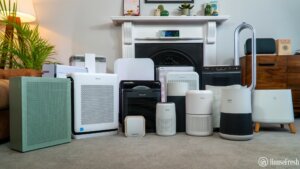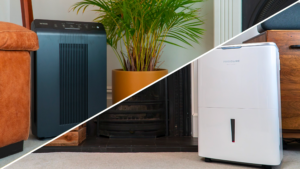Particulate matter, especially levels of 2.5 or less in diameter, is a significant concern as it can cause serious health issues. Air pollution varies throughout the world, and there are various outdoor sources of PM2.5, with vehicle exhaust fumes being one of the most common. It can also be produced in your home by cooking and smoking.
But don’t worry if you’re still unsure about what PM 2.5 means and why it can be so harmful, as we’ll be exploring all that in this article.
We’ll also look at practical ways to reduce levels in your home and improve indoor air quality, including choosing the best air purifier for PM2.5.
What does “PM2.5” mean? (and why it can be bad for you)
PM stands for particulate matter (particle pollution) and is made up of tiny pieces of solids or liquids in the air. According to the CDC, this can include dust, dirt, smoke and soot.
But why 2.5? The measurement refers to the fact that the pieces are 2.5 microns (or micrometers) in diameter or less. You’d need an electron microscope to see them but to give you an idea of exactly how tiny 2.5 microns is, human hair has a diameter of 70 microns, so a PM2.5 particle is 30 times smaller than a strand of your hair.

| 🚗 Outdoor Sources of PM2.5 | 🍳 Indoor Sources of PM2.5 |
|---|---|
You might notice that the air outside sometimes looks hazy with reduced visibility due to elevated levels of PM2.5, often because there is little or no wind. A PM of a diameter ranging between 0.1 µm-1 µm can remain suspended in the air for days or weeks, leading to haziness. These minuscule particles come from a mixture of outdoor and indoor sources. They primarily originate outdoors from vehicle exhausts (particularly diesel engines), such as cars, trucks, buses and trains. Power plants and forest and grass fires also generate PM2.5. | Indoor sources include everyday activities like cooking (particularly frying, sauteing and broiling) and simply burning candles. Tobacco smoke, fireplaces and fuel-burning space heaters, such as kerosene heaters, are other known causes. Also, according to the Massachusetts Environmental Public Health Tracking, chemicals from cleaning products are another prime cause of indoor particulate matter. |
Health concerns
The particles are so small that they can pose a real health problem. According to the New York State Department of Health, short-term effects of exposure include:
- Eye, nose, throat and lung irritation
- Sneezing
- Coughing
- Runny nose
- Shortness of breath
Yet there are more serious and long-term health impacts.
📖 The Environmental Protection Agency states that the particles can penetrate your lungs and even enter your bloodstream.
📖 The World Health Organization (WHO) reports that PM and other household indoor pollutants can inflame the airways and lungs, weaken immune responses and impact the capacity of your blood to carry oxygen.
📖 The New York State Department of Health has also linked PM2.5 exposure to more respiratory, cardiovascular and emergency hospital visits.
📖 A study published in Frontiers in Endocrinology found that acute and chronic exposure to particulate matter can increase the risk of death from heart disease, heart failure and stroke.
📖 A study published in the Journal of Thoracic Disease shows a pronounced link between PM2.5 and daily human mortality, particularly for older people.
📖 There is some good news because the same study also revealed that the lifespan of an American citizen increased by 0.35 years for every reduction of PM2.5 by 10 µg/m3.
While we might all be at risk from particle pollution, individuals with pre-existing conditions are especially vulnerable. For example, fine particles can significantly aggravate the condition if you have asthma. Older people are also susceptible, as we touched on earlier. Similarly, children are more susceptible to the harmful effects of PM2.5. This is attributed to the fact that their lungs are still developing, and they breathe more air per pound of body weight than adults.
8 ways to reduce PM2.5 levels at home to improve indoor air quality
1. Use extractor fans
Cooking produces many things, including smells, moisture, grease and smoke. You might find the noise a pain, but switching on your kitchen hood and fans during and after cooking is crucial.
This will help to clear smoke, oil and other ingredients that have evaporated into the air. As well as significantly reducing your exposure to PM2.5, using kitchen fans and the cooking hood will also limit damage to your walls and kitchen cabinets.
If possible, get an extracting cooker hood, also called a vented hood or ducted hood, rather than a recirculating one. Extracting hoods send the air out of your home, reducing the chance of breathing in particles.
2. Ventilate
Outdoor air has 2 to 5 times fewer pollutants than indoor air, according to the American Lung Association. Opening doors and windows for around 15 minutes daily can bring in cleaner outdoor air while reducing household pollutants inside your home.
However, if you live near a busy road or highway, you could inadvertently release more pollutants. Be sure to keep windows and doors closed during peak traffic times.
It’s important to be equally cautious if there is a wildfire nearby or you live near a factory with high emissions.
3. Vacuum regularly
Frequent vacuuming can significantly help to remove polluting particles. Carpets can house allergens, so it’s advisable to vacuum these often, especially If you or someone in your home suffers from allergies.
Consider even replacing your carpets with solid flooring if possible, as this will be much easier to clean.
Air Now, which provides information about air quality in the U.S. advises using a vacuum with a HEPA filter. Vacuums without this feature are more likely to stir up particles rather than capture them.
4. Smoke outdoors
While using an air purifier for cigarette smoke will significantly help to reduce PM2.5, the absolute best thing you can do is not smoke indoors at all. Even after you’ve finished smoking, it can remain in the air for hours and spread around your house.
Opening a window or door can sometimes do more harm than good because the smoke can blow back inside. It can then attach itself to soft surfaces like bedding and carpets and build up over time, leading to harmful, third-hand smoking.
Close the door behind you when smoking outside and move as far away from your home as possible.
5. Know the risks of wood-burning stoves
A wood-burning stove can help to keep your home warm, especially during the winter months. However, a study conducted by the University of Sheffield in the UK has found that they can also release high levels of PM2.5.
If you want to continue using yours, burn only fully dried, untreated wood with a moisture content of 20% or less. Certain fuel types, such as wet logs, produce significantly more particulate matter than dry logs.
Open the flue damper before you use the stove — when wood doesn’t have an adequate supply of oxygen, it produces more smoke and possibly harmful emissions.
6. Be careful with candles
Anything that burns can generate particulate matter, including candles. However, many of us find them helpful for relaxation, so giving them up can be difficult. If this is you, then choose the right type of candle.
Paraffin wax, for example, releases far more PM2.5 than soy wax, according to a study published in the American Journal of Respiratory and Critical Care Medicine.
Blowing out candles can release PM2.5, so extinguish flames with a snuffer.
7. Choose better cleaning products
Keeping your home clean is important, but choose less-polluting products to minimize airborne contaminants like PM2.5 from circulating.
Use natural products such as white vinegar and baking soda if you can. But if you prefer shop-bought cleaning products, choose cream over spray cleaners.
Low-scent or fragrance-free products mean there’ll be less reactive chemistry, minimizing particulate matter release.
8. Use an air purifier
Air purifiers, also called air cleaners, are highly effective at removing particulate matter from the air and can therefore reduce the amount of pollution you breathe.
Always look for one with a HEPA filter, as this eliminates those tiny, fine particles. Equally, an activated carbon filter will effectively remove smells and gaseous pollutants.
Steer well clear from any purifier that produces ozone as this will increase the pollution in your home and therefore put your health at risk.
Top 3 air purifiers for PM2.5
The most efficient way to improve air quality is to introduce an air purifier into your home. Nowadays, air purifiers (the good ones) are taken through rigorous scientific testing to make sure they can do what they claim, remove airborne PM2.5 particles.
To do this, an air purifier must contain a HEPA filter, a strong fan motor and be in the right-sized space.
Here are three of our favorite units we use for different rooms:
| 🛏️ FOR BEDROOMS | 🍳 FOR KITCHENS | 🛋️ FOR LIVING ROOMS | |
|---|---|---|---|
| Smart Air S | Levoit Core 300 | Blueair Blue Pure 211+ | |
 |  |  | |
| AIR CLEANING SPEED ⚡ | 29 minutes | 40 minutes | 18 minutes |
| CADR 👩🔬 | 185.4 CFM | 145 CFM | 350 CFM |
| FILTER TECHNOLOGY 💨 | HEPA filter | Pre-filter, H13 HEPA and Activated Carbon Pellets | HEPASilent™ filter |
| MAX ROOM SIZE 📏 | 430 sq. ft. | 219 sq. ft. | 540 sq. ft. |
| WEIGHT ⚖️ | 16.5 lbs (7.4 kg) | 7.48 lbs (3.4 kg) | 12.5 lbs (5.67 kg) |
| PROS 👍 | Looks stylish with its beechwood legs. | Small enough to sit on a countertop. | One-button operation. |
| CONS 👎 | Doesn’t come with an activated carbon filter as standard. | Doesn’t have an air quality sensor. | There isn’t an auto or sleep mode. |
| OUR REVIEW 🔍 | Smart Air S review | Levoit Core 300 review | Blueair 211+ review |
| PRICE 💵 | $179.95 | Price not available | $300.27 |
Last update on 2024-04-24 / Affiliate links / Images from Amazon Product Advertising API
Final thoughts
Increasing awareness about the health risks associated with PM2.5 means we can all minimize exposure. Using extractor fans and hoods while cooking is crucial, as is ventilating your home by opening windows and doors (avoiding peak traffic times). And if you have to smoke, always do so outside.
Also, be aware of the risks of wood-burning stoves and paraffin candles and choose less-polluting cleaning products wherever possible.
One of the most effective ways to remove particulate matter is via an air purifier, so be sure to add one of these units to your home.
SOURCES
- AirNow. (2023). Extremely High Levels of PM2.5: Steps to Reduce Your Exposure. airnow.gov
- American Lung Association. (2022). What Is Particulate Matter? lung.org
- Centers for Disease Control and Prevention. (2023). Particle Pollution. cdc.gov
- Environmental Protection Agency. (2022). What is PM, and how does it get into the air? epa.gov
- Gallagher, P. (2023). How to improve your indoor air quality at home. which.co.uk
- Hamanaka, R.B., Mutlu, G.M. (2018). Particulate Matter Air Pollution: Effects on the Cardiovascular System. ncbi.nlm.nih.gov
- Jakpor, O. (2012). Indoor Air Pollution: A Comparison Of Fine Particulate Matter (PM2.5) Emissions From Paraffin And Soy Candles. atsjournals.org
- Massachusetts Environmental Public Health Tracking. (2022). Irritant sources. matracking.ehs.state.ma.us
- Mayo Clinic. (2022). What is thirdhand smoke, and why is it a concern? mayoclinic.org
- New York State Department of Health. (2018). Fine Particles (PM 2.5) Questions and Answers. health.ny.gov
- Stone, L. (2022). Clean Up Atelier. Could Your Candle be Harming You? cleanup-atelier.de
- University of Sheffield. (2020). Indoor wood stoves release harmful emissions into our homes, study finds. sheffield.ac.uk
- World Health Organization. (2022). Household air pollution. who.int
- Xing, Y-F. et al. (2016). The impact of PM2.5 on the human respiratory system. ncbi.nlm.nih.gov
Last update on 2024-04-24 / Affiliate links / Images from Amazon Product Advertising API






